Health and Sociopolitical Issues in Aged Care: Assessment 2 Analysis
VerifiedAdded on 2022/09/14
|8
|1977
|14
Homework Assignment
AI Summary
This homework assignment analyzes aged care services, focusing on residential aged care, health aging models, and the user pays system in Australia. The assignment addresses service design for senior independence, explaining and critiquing health service delivery models like the user pays system. The analysis includes discussions of positive and negative factors associated with these models, such as funding challenges and ethical issues related to service access and quality. The student explores the complexities of aged care, including the impact of government funding, ethical considerations, and the challenges faced by both service providers and recipients. The assignment also highlights the importance of providing care and support services to older Australians, considering various aspects of their well-being.
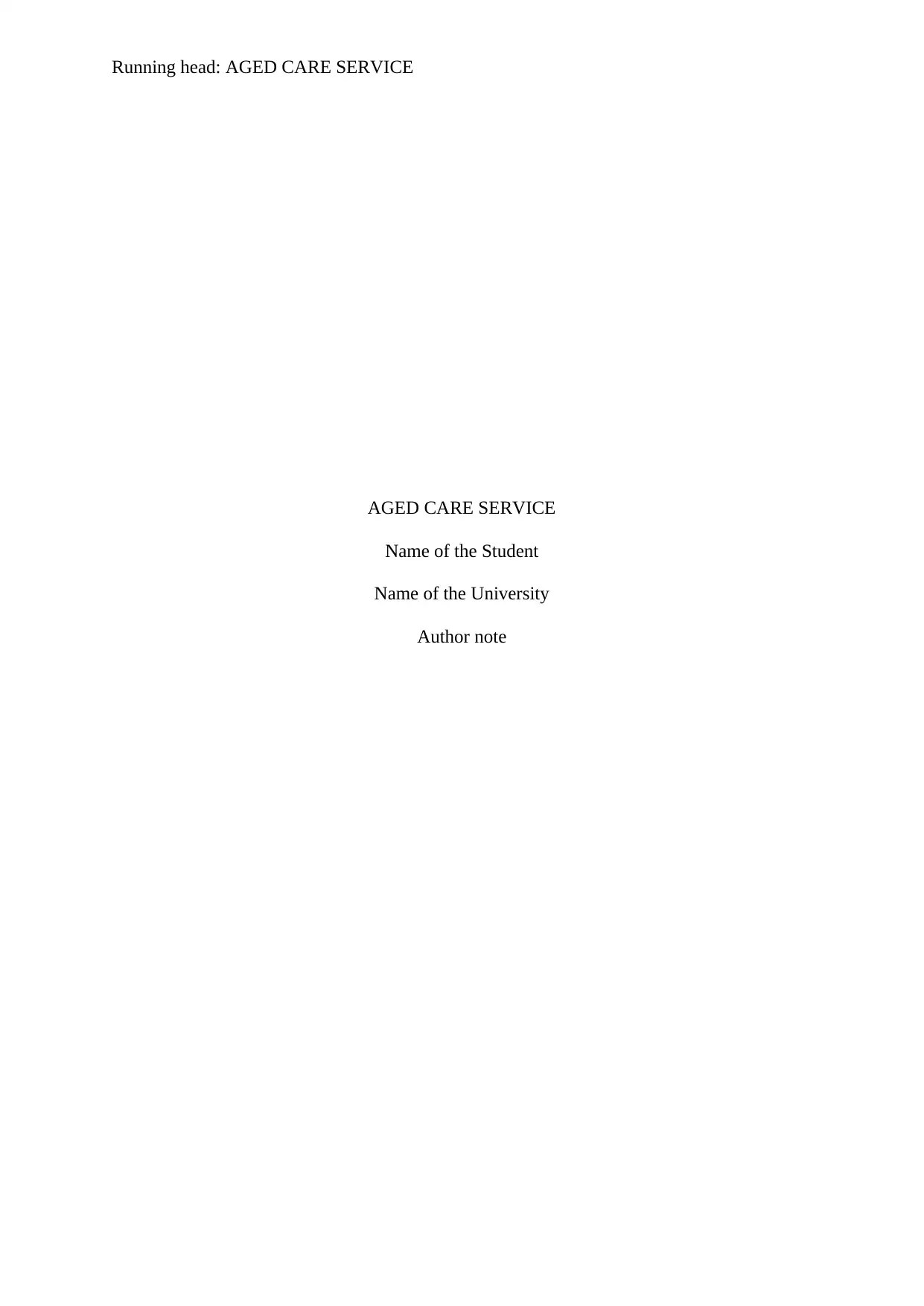
Running head: AGED CARE SERVICE
AGED CARE SERVICE
Name of the Student
Name of the University
Author note
AGED CARE SERVICE
Name of the Student
Name of the University
Author note
Paraphrase This Document
Need a fresh take? Get an instant paraphrase of this document with our AI Paraphraser
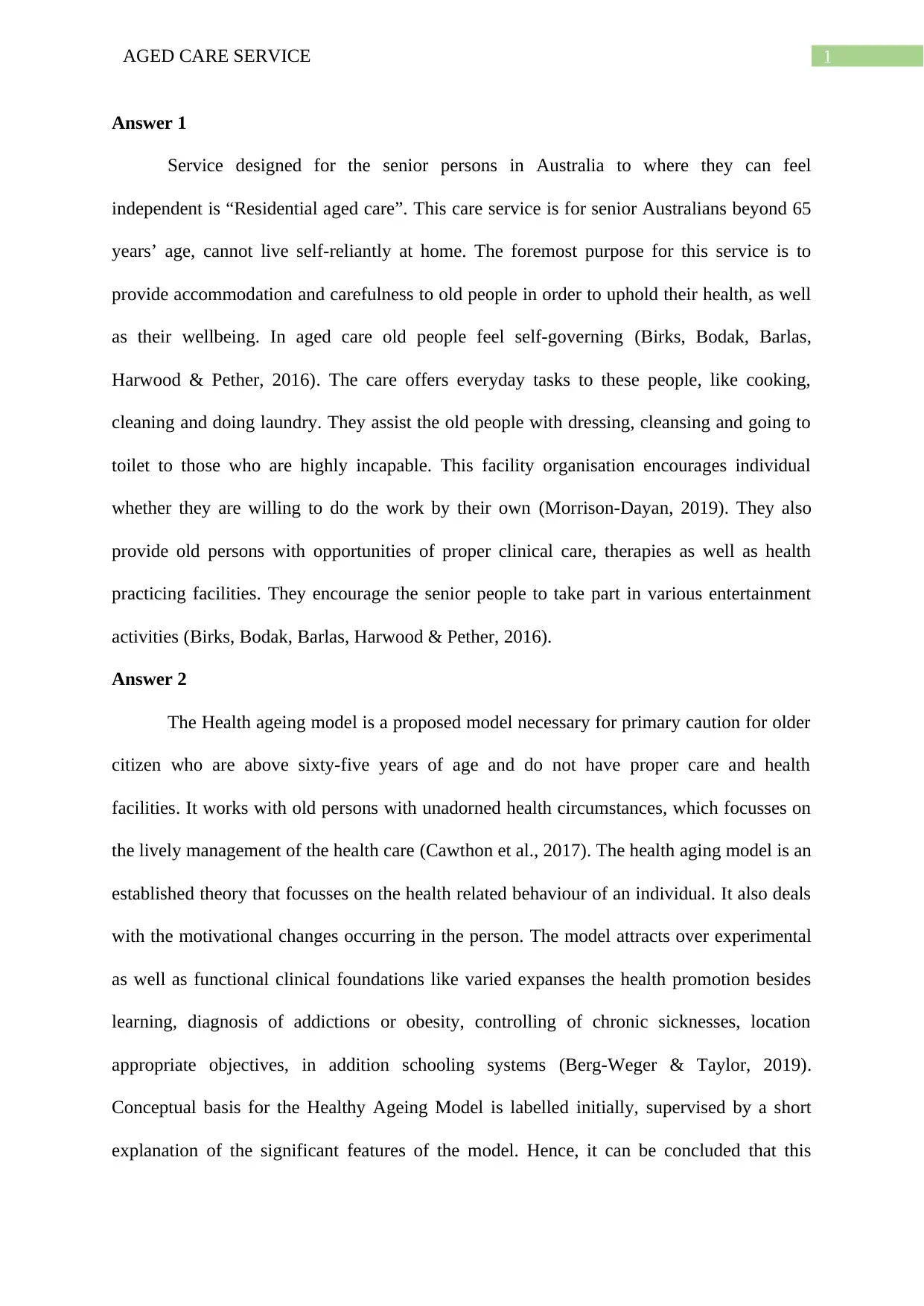
1AGED CARE SERVICE
Answer 1
Service designed for the senior persons in Australia to where they can feel
independent is “Residential aged care”. This care service is for senior Australians beyond 65
years’ age, cannot live self-reliantly at home. The foremost purpose for this service is to
provide accommodation and carefulness to old people in order to uphold their health, as well
as their wellbeing. In aged care old people feel self-governing (Birks, Bodak, Barlas,
Harwood & Pether, 2016). The care offers everyday tasks to these people, like cooking,
cleaning and doing laundry. They assist the old people with dressing, cleansing and going to
toilet to those who are highly incapable. This facility organisation encourages individual
whether they are willing to do the work by their own (Morrison‐Dayan, 2019). They also
provide old persons with opportunities of proper clinical care, therapies as well as health
practicing facilities. They encourage the senior people to take part in various entertainment
activities (Birks, Bodak, Barlas, Harwood & Pether, 2016).
Answer 2
The Health ageing model is a proposed model necessary for primary caution for older
citizen who are above sixty-five years of age and do not have proper care and health
facilities. It works with old persons with unadorned health circumstances, which focusses on
the lively management of the health care (Cawthon et al., 2017). The health aging model is an
established theory that focusses on the health related behaviour of an individual. It also deals
with the motivational changes occurring in the person. The model attracts over experimental
as well as functional clinical foundations like varied expanses the health promotion besides
learning, diagnosis of addictions or obesity, controlling of chronic sicknesses, location
appropriate objectives, in addition schooling systems (Berg-Weger & Taylor, 2019).
Conceptual basis for the Healthy Ageing Model is labelled initially, supervised by a short
explanation of the significant features of the model. Hence, it can be concluded that this
Answer 1
Service designed for the senior persons in Australia to where they can feel
independent is “Residential aged care”. This care service is for senior Australians beyond 65
years’ age, cannot live self-reliantly at home. The foremost purpose for this service is to
provide accommodation and carefulness to old people in order to uphold their health, as well
as their wellbeing. In aged care old people feel self-governing (Birks, Bodak, Barlas,
Harwood & Pether, 2016). The care offers everyday tasks to these people, like cooking,
cleaning and doing laundry. They assist the old people with dressing, cleansing and going to
toilet to those who are highly incapable. This facility organisation encourages individual
whether they are willing to do the work by their own (Morrison‐Dayan, 2019). They also
provide old persons with opportunities of proper clinical care, therapies as well as health
practicing facilities. They encourage the senior people to take part in various entertainment
activities (Birks, Bodak, Barlas, Harwood & Pether, 2016).
Answer 2
The Health ageing model is a proposed model necessary for primary caution for older
citizen who are above sixty-five years of age and do not have proper care and health
facilities. It works with old persons with unadorned health circumstances, which focusses on
the lively management of the health care (Cawthon et al., 2017). The health aging model is an
established theory that focusses on the health related behaviour of an individual. It also deals
with the motivational changes occurring in the person. The model attracts over experimental
as well as functional clinical foundations like varied expanses the health promotion besides
learning, diagnosis of addictions or obesity, controlling of chronic sicknesses, location
appropriate objectives, in addition schooling systems (Berg-Weger & Taylor, 2019).
Conceptual basis for the Healthy Ageing Model is labelled initially, supervised by a short
explanation of the significant features of the model. Hence, it can be concluded that this
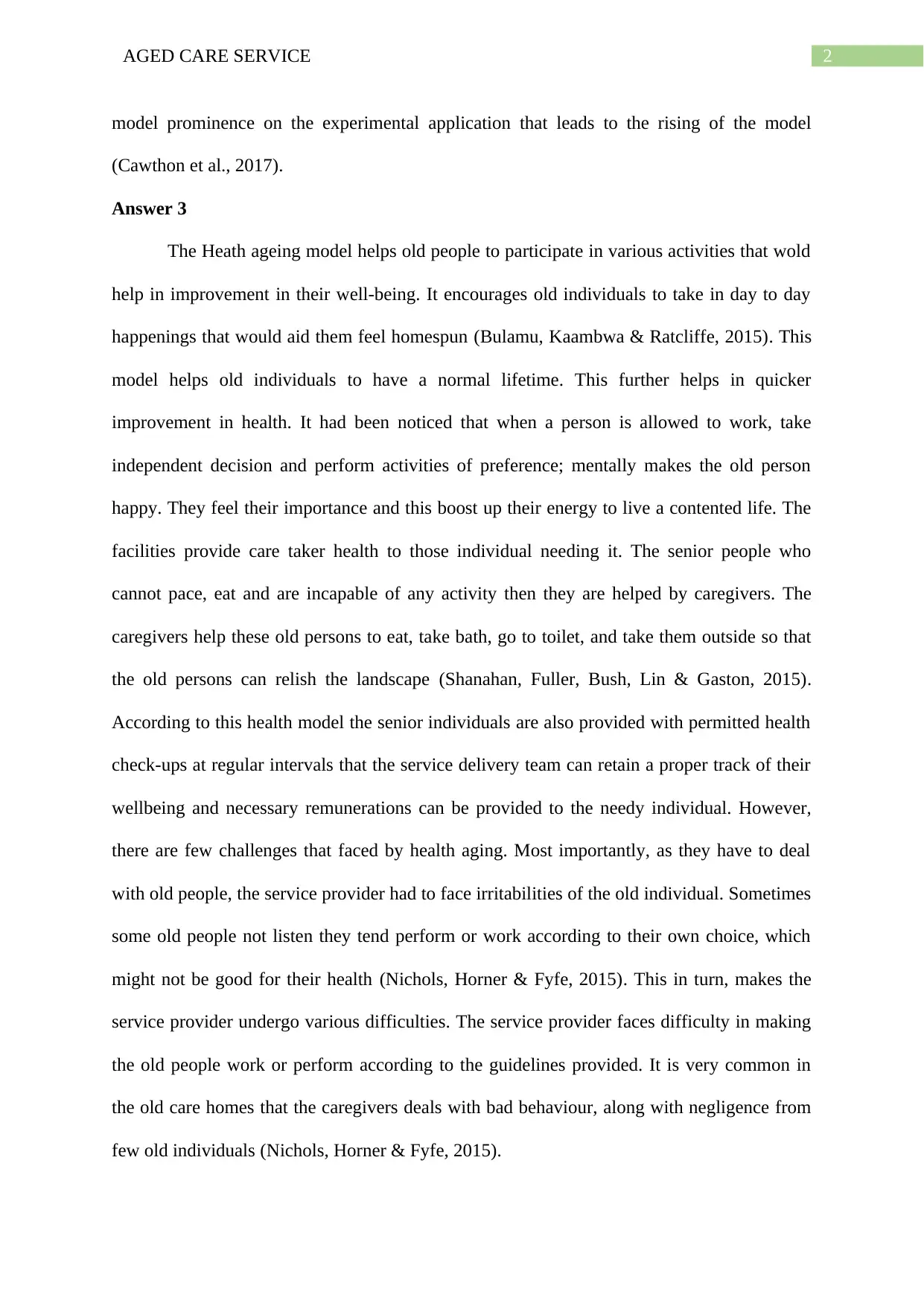
2AGED CARE SERVICE
model prominence on the experimental application that leads to the rising of the model
(Cawthon et al., 2017).
Answer 3
The Heath ageing model helps old people to participate in various activities that wold
help in improvement in their well-being. It encourages old individuals to take in day to day
happenings that would aid them feel homespun (Bulamu, Kaambwa & Ratcliffe, 2015). This
model helps old individuals to have a normal lifetime. This further helps in quicker
improvement in health. It had been noticed that when a person is allowed to work, take
independent decision and perform activities of preference; mentally makes the old person
happy. They feel their importance and this boost up their energy to live a contented life. The
facilities provide care taker health to those individual needing it. The senior people who
cannot pace, eat and are incapable of any activity then they are helped by caregivers. The
caregivers help these old persons to eat, take bath, go to toilet, and take them outside so that
the old persons can relish the landscape (Shanahan, Fuller, Bush, Lin & Gaston, 2015).
According to this health model the senior individuals are also provided with permitted health
check-ups at regular intervals that the service delivery team can retain a proper track of their
wellbeing and necessary remunerations can be provided to the needy individual. However,
there are few challenges that faced by health aging. Most importantly, as they have to deal
with old people, the service provider had to face irritabilities of the old individual. Sometimes
some old people not listen they tend perform or work according to their own choice, which
might not be good for their health (Nichols, Horner & Fyfe, 2015). This in turn, makes the
service provider undergo various difficulties. The service provider faces difficulty in making
the old people work or perform according to the guidelines provided. It is very common in
the old care homes that the caregivers deals with bad behaviour, along with negligence from
few old individuals (Nichols, Horner & Fyfe, 2015).
model prominence on the experimental application that leads to the rising of the model
(Cawthon et al., 2017).
Answer 3
The Heath ageing model helps old people to participate in various activities that wold
help in improvement in their well-being. It encourages old individuals to take in day to day
happenings that would aid them feel homespun (Bulamu, Kaambwa & Ratcliffe, 2015). This
model helps old individuals to have a normal lifetime. This further helps in quicker
improvement in health. It had been noticed that when a person is allowed to work, take
independent decision and perform activities of preference; mentally makes the old person
happy. They feel their importance and this boost up their energy to live a contented life. The
facilities provide care taker health to those individual needing it. The senior people who
cannot pace, eat and are incapable of any activity then they are helped by caregivers. The
caregivers help these old persons to eat, take bath, go to toilet, and take them outside so that
the old persons can relish the landscape (Shanahan, Fuller, Bush, Lin & Gaston, 2015).
According to this health model the senior individuals are also provided with permitted health
check-ups at regular intervals that the service delivery team can retain a proper track of their
wellbeing and necessary remunerations can be provided to the needy individual. However,
there are few challenges that faced by health aging. Most importantly, as they have to deal
with old people, the service provider had to face irritabilities of the old individual. Sometimes
some old people not listen they tend perform or work according to their own choice, which
might not be good for their health (Nichols, Horner & Fyfe, 2015). This in turn, makes the
service provider undergo various difficulties. The service provider faces difficulty in making
the old people work or perform according to the guidelines provided. It is very common in
the old care homes that the caregivers deals with bad behaviour, along with negligence from
few old individuals (Nichols, Horner & Fyfe, 2015).
⊘ This is a preview!⊘
Do you want full access?
Subscribe today to unlock all pages.

Trusted by 1+ million students worldwide
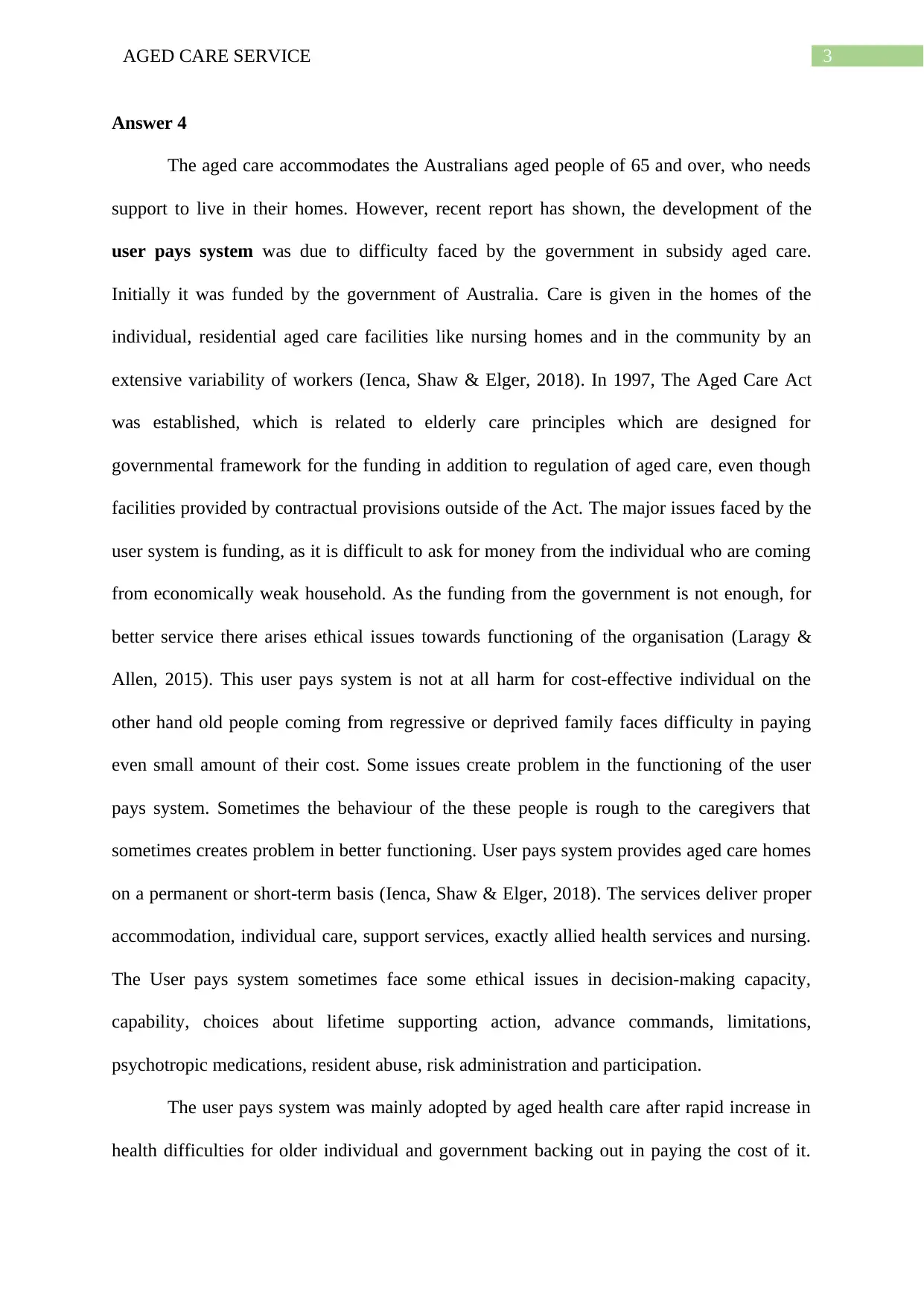
3AGED CARE SERVICE
Answer 4
The aged care accommodates the Australians aged people of 65 and over, who needs
support to live in their homes. However, recent report has shown, the development of the
user pays system was due to difficulty faced by the government in subsidy aged care.
Initially it was funded by the government of Australia. Care is given in the homes of the
individual, residential aged care facilities like nursing homes and in the community by an
extensive variability of workers (Ienca, Shaw & Elger, 2018). In 1997, The Aged Care Act
was established, which is related to elderly care principles which are designed for
governmental framework for the funding in addition to regulation of aged care, even though
facilities provided by contractual provisions outside of the Act. The major issues faced by the
user system is funding, as it is difficult to ask for money from the individual who are coming
from economically weak household. As the funding from the government is not enough, for
better service there arises ethical issues towards functioning of the organisation (Laragy &
Allen, 2015). This user pays system is not at all harm for cost-effective individual on the
other hand old people coming from regressive or deprived family faces difficulty in paying
even small amount of their cost. Some issues create problem in the functioning of the user
pays system. Sometimes the behaviour of the these people is rough to the caregivers that
sometimes creates problem in better functioning. User pays system provides aged care homes
on a permanent or short-term basis (Ienca, Shaw & Elger, 2018). The services deliver proper
accommodation, individual care, support services, exactly allied health services and nursing.
The User pays system sometimes face some ethical issues in decision-making capacity,
capability, choices about lifetime supporting action, advance commands, limitations,
psychotropic medications, resident abuse, risk administration and participation.
The user pays system was mainly adopted by aged health care after rapid increase in
health difficulties for older individual and government backing out in paying the cost of it.
Answer 4
The aged care accommodates the Australians aged people of 65 and over, who needs
support to live in their homes. However, recent report has shown, the development of the
user pays system was due to difficulty faced by the government in subsidy aged care.
Initially it was funded by the government of Australia. Care is given in the homes of the
individual, residential aged care facilities like nursing homes and in the community by an
extensive variability of workers (Ienca, Shaw & Elger, 2018). In 1997, The Aged Care Act
was established, which is related to elderly care principles which are designed for
governmental framework for the funding in addition to regulation of aged care, even though
facilities provided by contractual provisions outside of the Act. The major issues faced by the
user system is funding, as it is difficult to ask for money from the individual who are coming
from economically weak household. As the funding from the government is not enough, for
better service there arises ethical issues towards functioning of the organisation (Laragy &
Allen, 2015). This user pays system is not at all harm for cost-effective individual on the
other hand old people coming from regressive or deprived family faces difficulty in paying
even small amount of their cost. Some issues create problem in the functioning of the user
pays system. Sometimes the behaviour of the these people is rough to the caregivers that
sometimes creates problem in better functioning. User pays system provides aged care homes
on a permanent or short-term basis (Ienca, Shaw & Elger, 2018). The services deliver proper
accommodation, individual care, support services, exactly allied health services and nursing.
The User pays system sometimes face some ethical issues in decision-making capacity,
capability, choices about lifetime supporting action, advance commands, limitations,
psychotropic medications, resident abuse, risk administration and participation.
The user pays system was mainly adopted by aged health care after rapid increase in
health difficulties for older individual and government backing out in paying the cost of it.
Paraphrase This Document
Need a fresh take? Get an instant paraphrase of this document with our AI Paraphraser
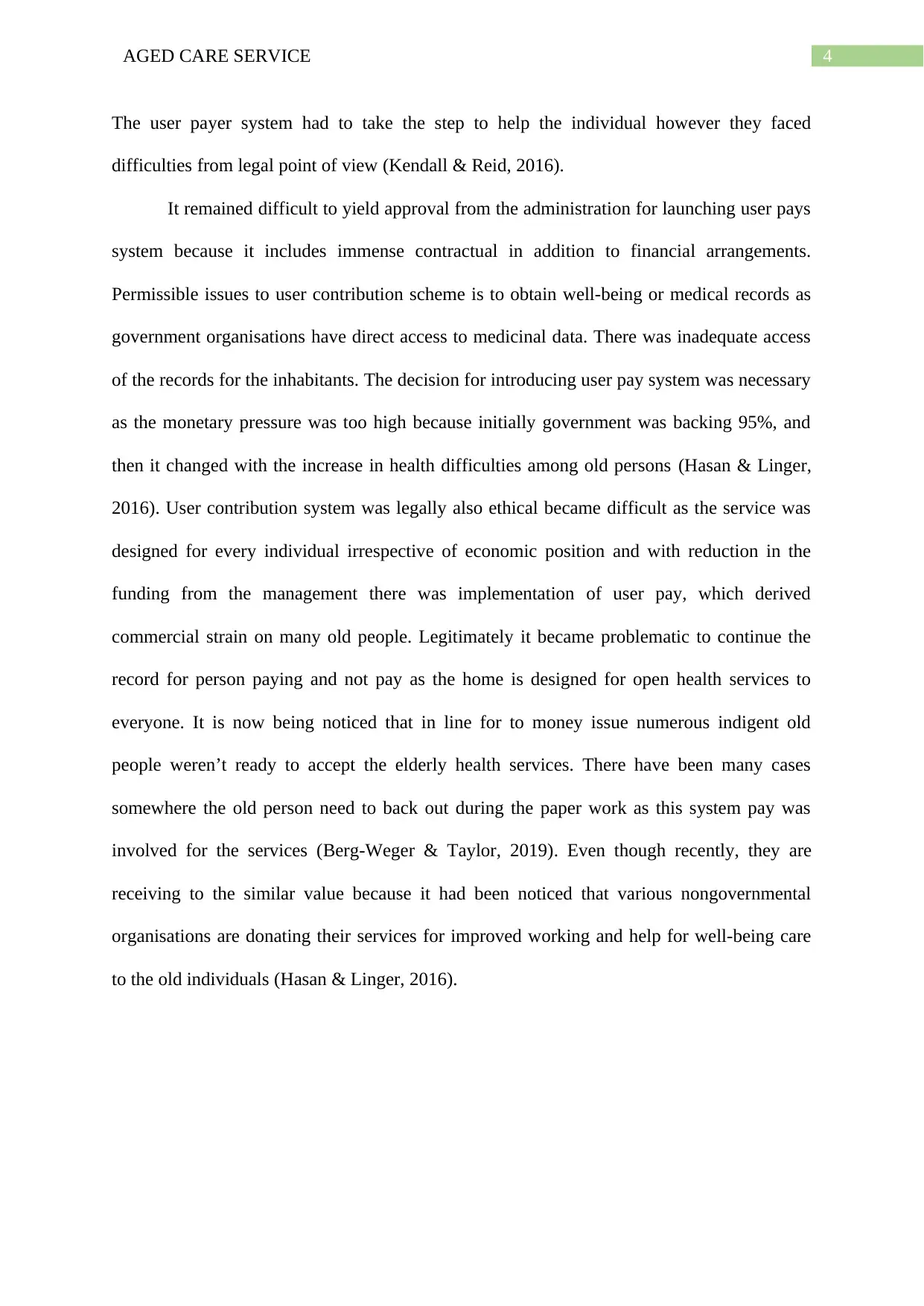
4AGED CARE SERVICE
The user payer system had to take the step to help the individual however they faced
difficulties from legal point of view (Kendall & Reid, 2016).
It remained difficult to yield approval from the administration for launching user pays
system because it includes immense contractual in addition to financial arrangements.
Permissible issues to user contribution scheme is to obtain well-being or medical records as
government organisations have direct access to medicinal data. There was inadequate access
of the records for the inhabitants. The decision for introducing user pay system was necessary
as the monetary pressure was too high because initially government was backing 95%, and
then it changed with the increase in health difficulties among old persons (Hasan & Linger,
2016). User contribution system was legally also ethical became difficult as the service was
designed for every individual irrespective of economic position and with reduction in the
funding from the management there was implementation of user pay, which derived
commercial strain on many old people. Legitimately it became problematic to continue the
record for person paying and not pay as the home is designed for open health services to
everyone. It is now being noticed that in line for to money issue numerous indigent old
people weren’t ready to accept the elderly health services. There have been many cases
somewhere the old person need to back out during the paper work as this system pay was
involved for the services (Berg-Weger & Taylor, 2019). Even though recently, they are
receiving to the similar value because it had been noticed that various nongovernmental
organisations are donating their services for improved working and help for well-being care
to the old individuals (Hasan & Linger, 2016).
The user payer system had to take the step to help the individual however they faced
difficulties from legal point of view (Kendall & Reid, 2016).
It remained difficult to yield approval from the administration for launching user pays
system because it includes immense contractual in addition to financial arrangements.
Permissible issues to user contribution scheme is to obtain well-being or medical records as
government organisations have direct access to medicinal data. There was inadequate access
of the records for the inhabitants. The decision for introducing user pay system was necessary
as the monetary pressure was too high because initially government was backing 95%, and
then it changed with the increase in health difficulties among old persons (Hasan & Linger,
2016). User contribution system was legally also ethical became difficult as the service was
designed for every individual irrespective of economic position and with reduction in the
funding from the management there was implementation of user pay, which derived
commercial strain on many old people. Legitimately it became problematic to continue the
record for person paying and not pay as the home is designed for open health services to
everyone. It is now being noticed that in line for to money issue numerous indigent old
people weren’t ready to accept the elderly health services. There have been many cases
somewhere the old person need to back out during the paper work as this system pay was
involved for the services (Berg-Weger & Taylor, 2019). Even though recently, they are
receiving to the similar value because it had been noticed that various nongovernmental
organisations are donating their services for improved working and help for well-being care
to the old individuals (Hasan & Linger, 2016).
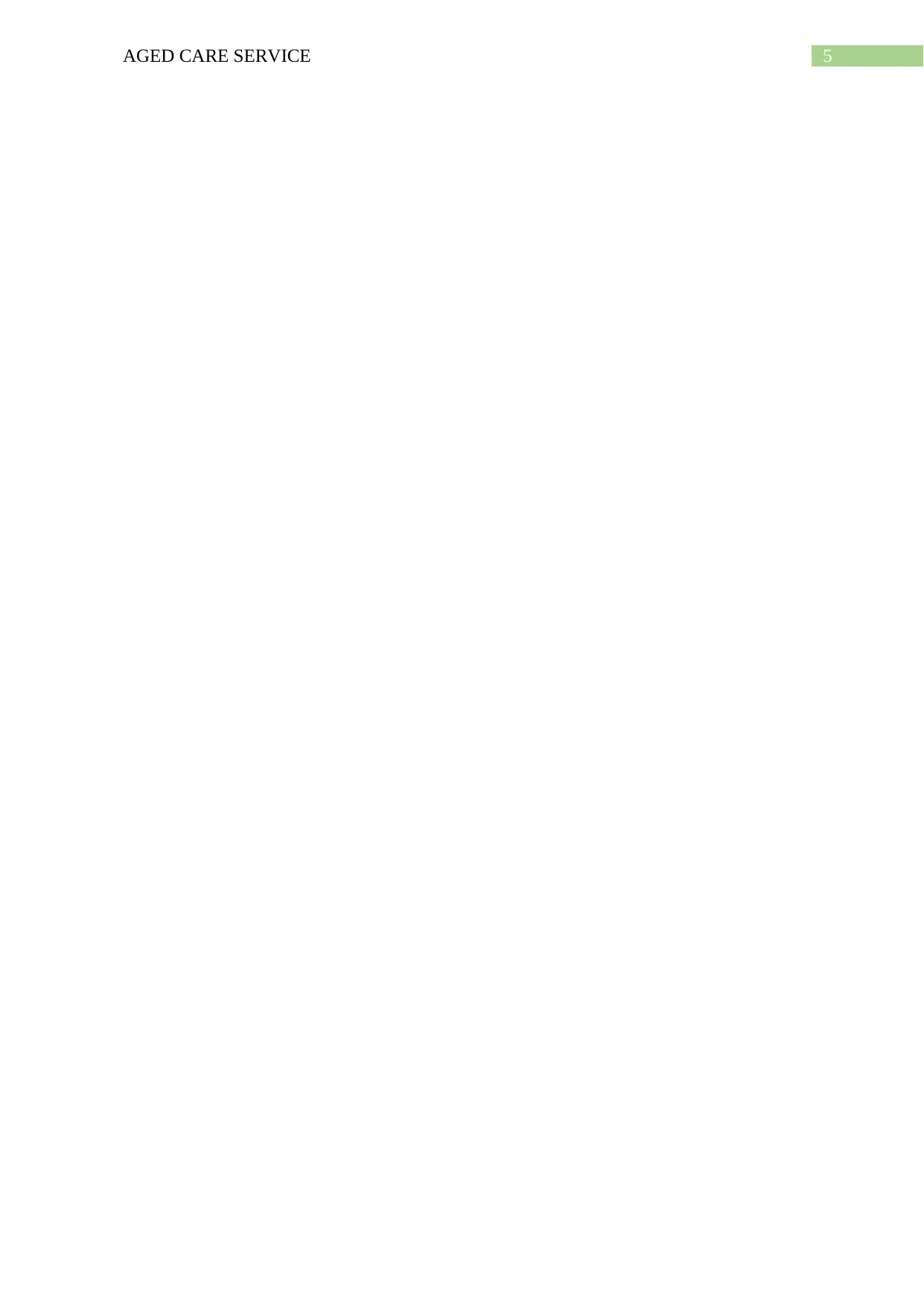
5AGED CARE SERVICE
⊘ This is a preview!⊘
Do you want full access?
Subscribe today to unlock all pages.

Trusted by 1+ million students worldwide
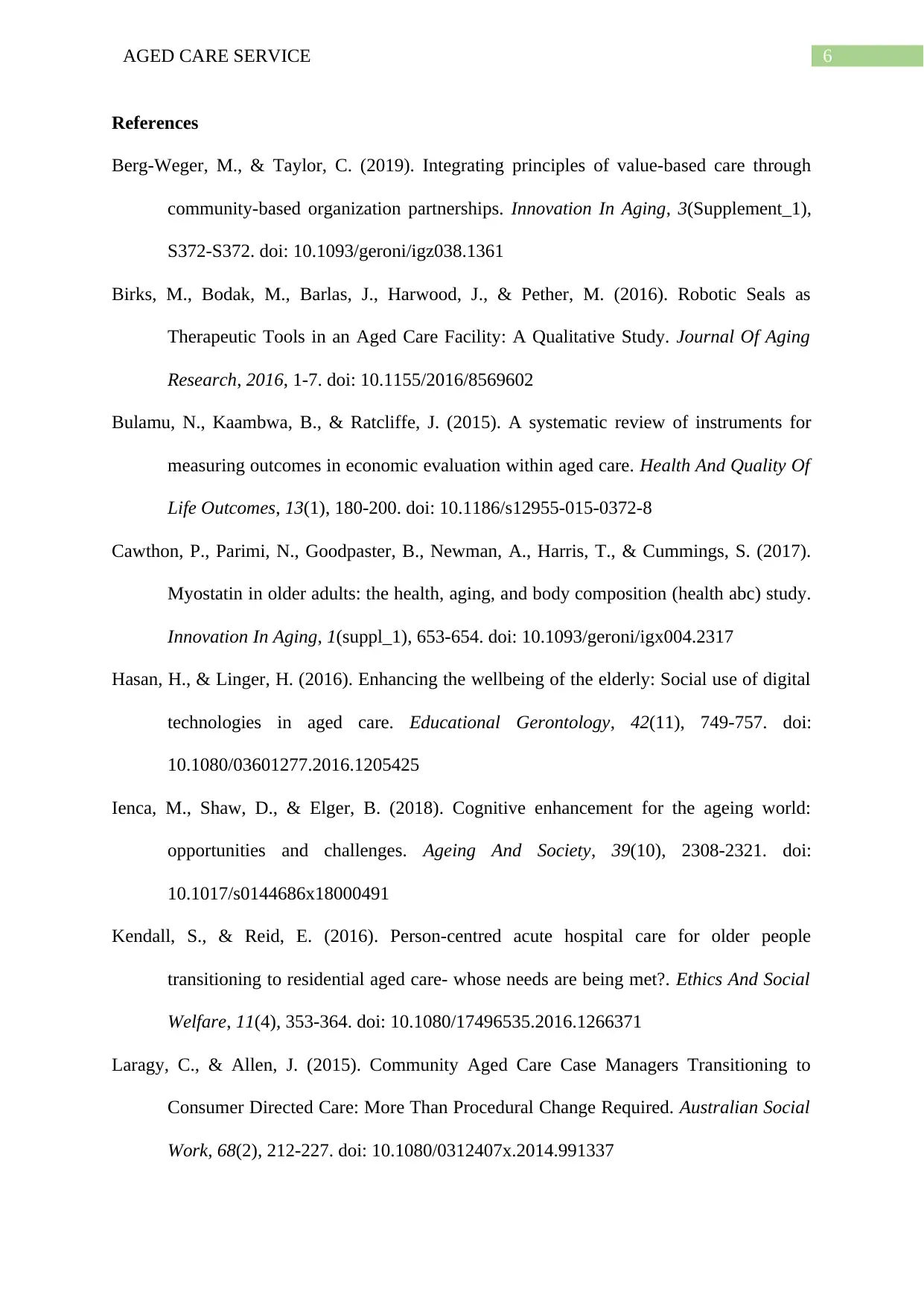
6AGED CARE SERVICE
References
Berg-Weger, M., & Taylor, C. (2019). Integrating principles of value-based care through
community-based organization partnerships. Innovation In Aging, 3(Supplement_1),
S372-S372. doi: 10.1093/geroni/igz038.1361
Birks, M., Bodak, M., Barlas, J., Harwood, J., & Pether, M. (2016). Robotic Seals as
Therapeutic Tools in an Aged Care Facility: A Qualitative Study. Journal Of Aging
Research, 2016, 1-7. doi: 10.1155/2016/8569602
Bulamu, N., Kaambwa, B., & Ratcliffe, J. (2015). A systematic review of instruments for
measuring outcomes in economic evaluation within aged care. Health And Quality Of
Life Outcomes, 13(1), 180-200. doi: 10.1186/s12955-015-0372-8
Cawthon, P., Parimi, N., Goodpaster, B., Newman, A., Harris, T., & Cummings, S. (2017).
Myostatin in older adults: the health, aging, and body composition (health abc) study.
Innovation In Aging, 1(suppl_1), 653-654. doi: 10.1093/geroni/igx004.2317
Hasan, H., & Linger, H. (2016). Enhancing the wellbeing of the elderly: Social use of digital
technologies in aged care. Educational Gerontology, 42(11), 749-757. doi:
10.1080/03601277.2016.1205425
Ienca, M., Shaw, D., & Elger, B. (2018). Cognitive enhancement for the ageing world:
opportunities and challenges. Ageing And Society, 39(10), 2308-2321. doi:
10.1017/s0144686x18000491
Kendall, S., & Reid, E. (2016). Person-centred acute hospital care for older people
transitioning to residential aged care- whose needs are being met?. Ethics And Social
Welfare, 11(4), 353-364. doi: 10.1080/17496535.2016.1266371
Laragy, C., & Allen, J. (2015). Community Aged Care Case Managers Transitioning to
Consumer Directed Care: More Than Procedural Change Required. Australian Social
Work, 68(2), 212-227. doi: 10.1080/0312407x.2014.991337
References
Berg-Weger, M., & Taylor, C. (2019). Integrating principles of value-based care through
community-based organization partnerships. Innovation In Aging, 3(Supplement_1),
S372-S372. doi: 10.1093/geroni/igz038.1361
Birks, M., Bodak, M., Barlas, J., Harwood, J., & Pether, M. (2016). Robotic Seals as
Therapeutic Tools in an Aged Care Facility: A Qualitative Study. Journal Of Aging
Research, 2016, 1-7. doi: 10.1155/2016/8569602
Bulamu, N., Kaambwa, B., & Ratcliffe, J. (2015). A systematic review of instruments for
measuring outcomes in economic evaluation within aged care. Health And Quality Of
Life Outcomes, 13(1), 180-200. doi: 10.1186/s12955-015-0372-8
Cawthon, P., Parimi, N., Goodpaster, B., Newman, A., Harris, T., & Cummings, S. (2017).
Myostatin in older adults: the health, aging, and body composition (health abc) study.
Innovation In Aging, 1(suppl_1), 653-654. doi: 10.1093/geroni/igx004.2317
Hasan, H., & Linger, H. (2016). Enhancing the wellbeing of the elderly: Social use of digital
technologies in aged care. Educational Gerontology, 42(11), 749-757. doi:
10.1080/03601277.2016.1205425
Ienca, M., Shaw, D., & Elger, B. (2018). Cognitive enhancement for the ageing world:
opportunities and challenges. Ageing And Society, 39(10), 2308-2321. doi:
10.1017/s0144686x18000491
Kendall, S., & Reid, E. (2016). Person-centred acute hospital care for older people
transitioning to residential aged care- whose needs are being met?. Ethics And Social
Welfare, 11(4), 353-364. doi: 10.1080/17496535.2016.1266371
Laragy, C., & Allen, J. (2015). Community Aged Care Case Managers Transitioning to
Consumer Directed Care: More Than Procedural Change Required. Australian Social
Work, 68(2), 212-227. doi: 10.1080/0312407x.2014.991337
Paraphrase This Document
Need a fresh take? Get an instant paraphrase of this document with our AI Paraphraser
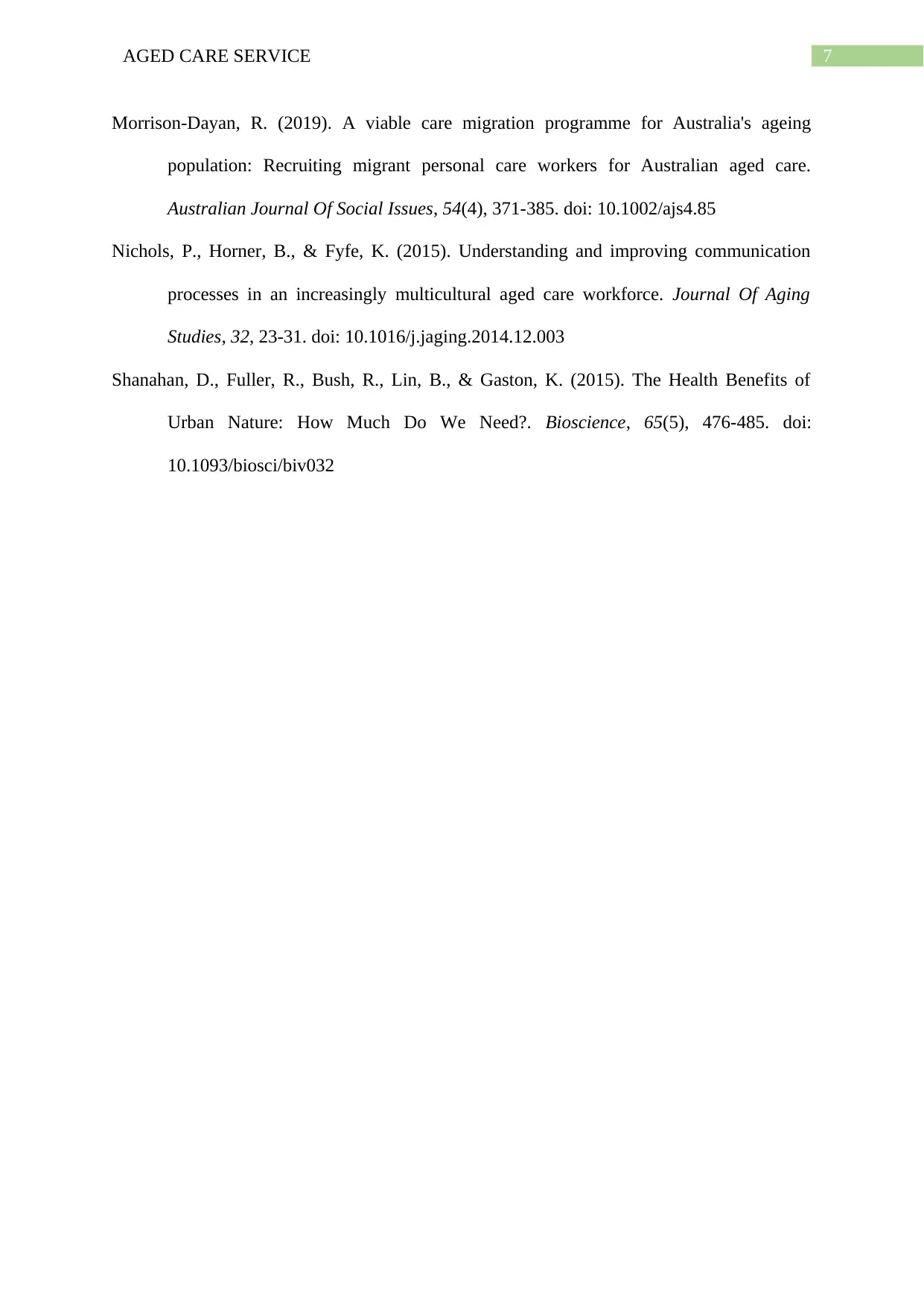
7AGED CARE SERVICE
Morrison‐Dayan, R. (2019). A viable care migration programme for Australia's ageing
population: Recruiting migrant personal care workers for Australian aged care.
Australian Journal Of Social Issues, 54(4), 371-385. doi: 10.1002/ajs4.85
Nichols, P., Horner, B., & Fyfe, K. (2015). Understanding and improving communication
processes in an increasingly multicultural aged care workforce. Journal Of Aging
Studies, 32, 23-31. doi: 10.1016/j.jaging.2014.12.003
Shanahan, D., Fuller, R., Bush, R., Lin, B., & Gaston, K. (2015). The Health Benefits of
Urban Nature: How Much Do We Need?. Bioscience, 65(5), 476-485. doi:
10.1093/biosci/biv032
Morrison‐Dayan, R. (2019). A viable care migration programme for Australia's ageing
population: Recruiting migrant personal care workers for Australian aged care.
Australian Journal Of Social Issues, 54(4), 371-385. doi: 10.1002/ajs4.85
Nichols, P., Horner, B., & Fyfe, K. (2015). Understanding and improving communication
processes in an increasingly multicultural aged care workforce. Journal Of Aging
Studies, 32, 23-31. doi: 10.1016/j.jaging.2014.12.003
Shanahan, D., Fuller, R., Bush, R., Lin, B., & Gaston, K. (2015). The Health Benefits of
Urban Nature: How Much Do We Need?. Bioscience, 65(5), 476-485. doi:
10.1093/biosci/biv032
1 out of 8
Related Documents
Your All-in-One AI-Powered Toolkit for Academic Success.
+13062052269
info@desklib.com
Available 24*7 on WhatsApp / Email
![[object Object]](/_next/static/media/star-bottom.7253800d.svg)
Unlock your academic potential
Copyright © 2020–2025 A2Z Services. All Rights Reserved. Developed and managed by ZUCOL.





